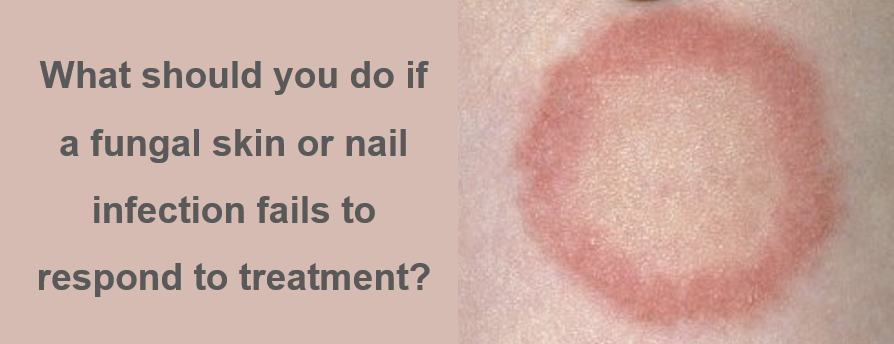Tinea is not responding to standard treatment – what should I do?
Tinea is a generic name for superficial skin, nail and hair infection caused mainly by dermatophytes. Dermatophytes (e.g. Trichophyton, Microsporum, Epidermophyton spp.) are fungi with the ability to metabolise the keratin found in hair, nails, and epidermis. Tinea can also be caused by non-dermatophyte moulds and yeasts like Candida. This is particularly the case with onychomycosis (tinea unguium), tinea versicolor and tinea nigra.
Due to the broad spectrum of pathogens involved, direct microscopy and fungal culture are important in making the diagnosis. Instructions on how to collect skin scrapings, hair samples and nail clippings can be found in the guidelines mentioned below. False negative microbiology may occur if the sample collected is too superficial (e.g. a swab) or if insufficient material is submitted to the laboratory.

The choice of antifungal treatment depends on the causative species, as well as the extent and depth of the infection:
- Terbinafine 1% cream and clotrimazole 1% cream can only be used to treat superficial cutaneous infection.
- Systemic antifungals like terbinafine, itraconazole, and griseofulvin are used to treat hair follicle infection, extensive cutaneous infection, or resistant or refractory disease.
- Nystatin is an effective treatment for infections caused by Candida and Candida-like species but it is important to note that dermatophytes are resistant to Nystatin.
- In case of onychomycosis, monotherapy with topical agents is limited to early, localised onychomycosis. Terbinafine and itraconazole are the most commonly used systemic oral antifungals (see guidelines for dosing).

In case of poor response to treatment, it is important to repeat fungal culture to confirm the presence of a fungal pathogen and test the isolate for resistance (this has to be specifically mentioned on the request form). It is also important to assess adherence to treatment and instructions given regarding preventive measures (washing and disinfecting clothes and shoes, not sharing towels, sport gear, clothes, combs, or hairbrushes, use of desiccating powder and wearing of footwear in public areas, including gym, pool, and public showers).
It is also good practice to assess household members for superficial fungal infection and to treat accordingly. It is important to ask about pets and their skin/fur issues (e.g. patches of missing fur) as well, and refer to veterinary medicine if needed.
A number of skin diseases can present similarly to and/or concomitantly with tinea whereby it is important to assess for presence of non-fungal underlying skin disease. The following diagnoses need to be considered in case of failure to respond to treatment: annular psoriasis, atopic dermatitis, seborrheic dermatitis, contact dermatitis, erythema multiforme, and in case of onychomycosis, repeated trauma, nail psoriasis, lichen planus, yellow nail syndrome and squamous cell carcinoma of the nail.
A referral to a dermatology clinic should be considered if oral antifungal treatment is required for a child, diagnosis is uncertain and treatment is unsuccessful, or if the patient is immunocompromised. In case of onychomycosis, a referral to a podiatrist is recommended. In some cases, the patient fails to improve despite multiple courses of antifungal therapy, or the fungal pathogen is resistant to all available antifungals. In these cases, surgical avulsion remains a treatment option to be discussed with the patient.

More information can be found at:
- NICE guideline: Fungal skin infection – body and groin
- British Association of Dermatologists: guidelines for the management of onychomycosis
- British Association of Dermatologists: guidelines for the management of tinea capitis
- The March Against Onychomycosis: A Systematic Review of the Sanitization Methods for Shoes, Socks, and Textiles

